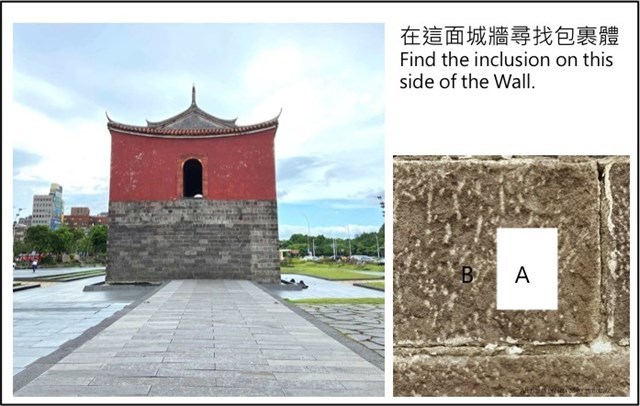Rock Fragment in Beimen #Xenolith?
登錄任務

1. 辨別包裹體是捕獲岩還是同源捕擄體?根據現場的觀察解釋你的答案。提示:同樣顏色?同樣質地?同類型岩石?
2.1 估計區域A的長度與寬度。
3. 宿主岩石比較可能是唭哩岸岩而不是安山岩。 (是/否)
4. 根據現場捕獲岩與宿主岩石的觀察,捕獲岩形成當時的台北環境可能是什麼?
5. (自主選擇) 尋找北門上其他可疑的包裹體。
6. (自由選擇)拍下北門與你、你的代表物、或是你的GPS裝置,歡迎上傳照片。
地質寶提供學習機會,透過觀察公布點、閱讀地質寶頁面、搜索/腦力激盪登錄任務的答案,讓尋寶玩家瞭解發生在地球上的地質現象。你不需要等待許可,請線上登錄這個地質寶,並將推測的答案寄到Geocaching.com的信箱。記得,沒有答案的線上登錄會依地理尋寶守則刪除。請不要在線上log中公佈你的答案,感謝。歡迎給予FP!
Logging Tasks

1. Distinguish the inclusion. Is it a xenolith or cognate inclusion? Explain your answer based on the observation at the spot.
Hint: Are they in the same color, same texture, or similar type of rock?
2. Estimate the length and width of Area A.
3. The host rock is more likely as Qilian Rock rather than Andesite. (True/False)
4. Based observation on this xenolith and the host rock, what the environment would be when the xenolith was formed in ancient Taipei?
5. (Voluntary exploring) Find other inclusion(s) inside the rock(s) in Beimen.
6. (Optioanl) Photo the North Gate with you, your identifying item, or your GPS device. It is welcomed if you upload photos.
Earthcache nowadays provides learning opportunities about geology on earth by observing the posted coordinaiton, reading the listing page, and searching/brainstorming the answers to task. You don't need waiting the approval. Log this cache "Found it" and send me your suggested answers either via my profile, or via geocaching.com messaging. Remember, log without answers will be deleted by the geocaching guideline. Please, do not post your suggesting answers in the log. Favorite points appreciated.

北門石材的獨特處
北門使用的石材有安山岩與砂岩,這些石材受到台北不同的地質活動而形成,少數石材內還有捕獲岩。北門不只記錄台北歷史的文化層面,還記錄了地質層面。
這個地質寶要做什麼?
觀察和區辨北門使用的石材。增加對台北地區岩石類型的知識。發現與瞭解捕獲岩。
北門歷史

台北府城是台灣的國定古蹟,保留至今的建築有北門、東門、南門、與小南門,不過只有北門還保有1884年建造完工時的原來樣式,可惜的是西門與大多數的城牆已遭到拆除,這些城牆使用的石材被用來建造台北的其他建築,可參考一些傳統寶的介紹瞭解這些石材的起源與留存。(GC8HBCK, GC75KRH, & GC8Z9JH)
北門使用的不同石材
北門石材有兩種主要類型的岩石,分別是火成岩與沉積岩。這些岩石因為台北地區不同的地質活動而形成。觀察下方圖片,可以看到北門與其他歷史建物石材有不同的顏色與質地,表示可能使用不只一種石材。

北門使用的安山岩與砂岩
內湖大直地區產出的安山岩是一種火成岩,這些岩石可能跟大屯山第一、二階段火山噴發活動相關,安山岩是由火山中性岩漿形成,這裡的安山岩有豐富完整的斑晶。和北門使用的砂岩相比,安山岩硬度比較高且顏色比較深。

北門使用的砂岩來自唭哩岸,又稱作唭哩岸岩。唭哩岸岩屬於台北盆地的沉積岩,特徵是黃色、沙子大小的顆粒組成、與明顯的層理特徵。

北門石材中的捕獲岩
少數北門使用的石材可以觀察到捕獲岩。
捕獲岩是包裹在大岩石中的岩石碎片,這些大岩石(宿主岩石)後續發展與固化成岩。捕獲岩可在一些地方形成,像是岩漿庫的邊緣、火山噴發熔岩管道的外壁、或是地表流動岩漿的底部。
地質學上,捕獲岩幾乎專門指稱火成岩的包裹體,不過,按較寬鬆的定義來說,包裹在沉積岩中的岩石碎片也可以稱做捕獲岩。宿主岩石成岩過程中高溫與高壓可能會讓捕獲岩發生變質作用,進而改變了顏色與質地。

嚴謹的捕獲岩定義上為包裹在內的岩石必須和外在岩石有可辨識的不同,若是包裹在內的岩石與外在岩石為相似類型,則稱作同源捕擄體。
包裹體和宿主岩石可能礦物組成不同,分析捕獲岩的岩石組成可以透露宿主岩石成岩之前的地質訊息,捕獲岩甚至可以提供地涵的組成訊息
Rock Fragment in Beimen #Xenolith?
The uniqueness of rock material in Beimen
Rock materials used in Beimen are those rocks formed with different geological activities at Taipei. They are two main types of rock, andesite and sandstone. And xenolith can be discovered on few rock materials here. Beimen records not only the cultural side of Taipei's history but also the geological side.
What to do with this earthcache?
Observe and distinguish rock materials used in Beimen. Expand knowledge of the unique rock type at Taipei. Discover and recognize xenolith.
History of Beimen

Taipei City Walls is national historical monument in Taiwan. Remaining buildings are the North Gate (Beimen), the East Gate, the South Gate, and the Little South Gate. Beimen is the only gate that remained original appearance as it was built in 1884. Pity that the West Gate and most of the Taipei City Walls were tore down. Rock materials of those walls were used to other buildings in Taipei. Some caches in Taipei addressed the origin and remain of these rock materials, including GC8HBCK, GC75KRH, and GC8Z9JH.
Different Rock materials used in Beimen
There are two main types of rock used in Beimen, igneous rock and sedimentary rock. These rocks were formed with different geological activities in Taipei. From the picture below, rock materials in Beimen and other related historical relic are in different colors and textures which means more than one type of rock.

Andesite and Sandstone used in Beimen
Andesite in Beimen is from Neihu and Dazhi. Andesite is a type of igneous rock. These rocks may be related to volcanic activities in 2.8 Ma to 2.5 Ma ago or 0.8 Ma to 0.2 Ma ago (the first and second phase of Datun volcanic activity). Andesite is formed by volcanic intermediate lava. Andesite here may be abundant with porphyritic crystal. Compare to the sandstone used in Beimen, andesite is harder and in deeper color.

Sandstone used in Beimen is from Qilian, also called Qilian Rock. Qilian Rock is a type of sedimentary rock in Taipei Basin. Qilian Rock is featured in yellow color, sand-sized particles, and significant stratification feature.

Xenolith in rock material of Beimen
Few rock materials used in Beimen can be observed with xenolith.
A xenolith is a rock fragment which is enveloped in a larger rock (the host rock). The larger rock latter develops and solidifies. Xenoliths can be formed at the margins of a magma chamber, from the walls of an erupting lava conduit, or the base of a flowing lava on the Earth’s surface.
In geology, the term xenolith is almost exclusively associated with inclusions in igneous rock. However, a broad definition could include rock fragments which have become encased in sedimentary rock. Metamorphism may happen on xenoliths due to high temperature and pressure while the host rock solidified. The process may change xenolith's color and texture.

To be considered a true xenolith, the included rock must be identifiably different from the rock in which it is enveloped. An included rock of similar type is called an autolith or a cognate inclusion.
Inclusion may be different in minerals to the host rock. Analyzing rock composition of xenolith can reveal the geological information before the host rock is formed. Xenolith could even provide information about the composition of inaccessible mantle.
Reference
Xenolith @wiki
石頭吃石頭。江協堂
Principle of inclusions
國定古蹟簡介 中文 English
市定古蹟內湖清代採石場規劃調查研究
台北府城城牆